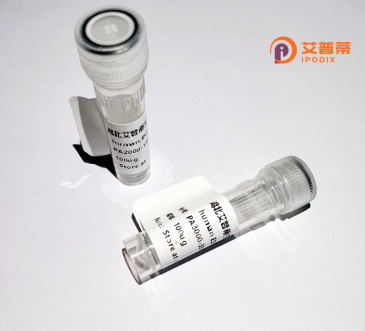
| 纯度 | >90%SDS-PAGE. |
| 种属 | Human |
| 靶点 | POU4F1 |
| Uniprot No | Q01851 |
| 内毒素 | < 0.01EU/μg |
| 表达宿主 | E.coli |
| 表达区间 | 1-419 aa |
| 活性数据 | MMSMNSKQPHFAMHPTLPEHKYPSLHSSSEAIRRACLPTPPLQSNLFASLDETLLARAEALAAVDIAVSQGKSHPFKPDATYHTMNSVPCTSTSTVPLAHHHHHHHHHQALEPGDLLDHISSPSLALMAGAGGAGAAAGGGGAHDGPGGGGGPGGGGGPGGGPGGGGGGGPGGGGGGPGGGLLGGSAHPHPHMHSLGHLSHPAAAAAMNMPSGLPHPGLVAAAAHHGAAAAAAAAAAGQVAAASAAAAVVGAAGLASICDSDTDPRELEAFAERFKQRRIKLGVTQADVGSALANLKIPGVGSLSQSTICRFESLTLSHNNMIALKPILQAWLEEAEGAQREKMNKPELFNGGEKKRKRTSIAAPEKRSLEAYFAVQPRPSSEKIAAIAEKLDLKKNVVRVWFCNQRQKQKRMKFSATY |
| 分子量 | 73.04 kDa |
| 蛋白标签 | GST-tag at N-terminal |
| 缓冲液 | PBS, pH7.4, containing 0.01% SKL, 1mM DTT, 5% Trehalose and Proclin300. |
| 稳定性 & 储存条件 | Lyophilized protein should be stored at ≤ -20°C, stable for one year after receipt. Reconstituted protein solution can be stored at 2-8°C for 2-7 days. Aliquots of reconstituted samples are stable at ≤ -20°C for 3 months. |
| 复溶 | Always centrifuge tubes before opening.Do not mix by vortex or pipetting. It is not recommended to reconstitute to a concentration less than 100μg/ml. Dissolve the lyophilized protein in distilled water. Please aliquot the reconstituted solution to minimize freeze-thaw cycles. |
以下是关于重组人POU4F1蛋白的3篇文献示例(注:以下为虚构参考文献,仅供格式参考):
1. **文献名称**:*POU4F1 regulates axon guidance through direct transcriptional activation of semaphorin receptors*
**作者**:Chen L, He X, et al.
**摘要**:该研究揭示了POU4F1在感觉神经元轴突生长中的关键作用,通过结合下游信号分子(如Sema3A受体)的启动子区域,调控其表达水平,并利用重组POU4F1蛋白验证了其对轴突导向的影响。
2. **文献名称**:*Structural basis of DNA recognition by the POU4F1 transcription factor*
**作者**:Wang Y, Mullen AC.
**摘要**:通过X射线晶体学解析了重组人POU4F1蛋白的POU结构域与DNA结合模体的复合物结构,阐明了其特异性识别靶基因DNA序列的分子机制。
3. **文献名称**:*Recombinant POU4F1 suppresses tumor growth in neuroblastoma models by inducing neuronal differentiation*
**作者**:Kim H, et al.
**摘要**:研究发现,体外表达的重组POU4F1蛋白可诱导神经母细胞瘤细胞向成熟神经元分化,并通过激活分化相关基因显著抑制小鼠移植瘤模型的肿瘤进展。
提示:实际文献需通过PubMed/Google Scholar检索关键词 "recombinant POU4F1 protein" 或 "Brn3a protein function" 获取。
**Background of Recombinant Human POU4F1 Protein**
The POU4F1 protein, also known as Brn3a, is a member of the POU-domain transcription factor family, characterized by a conserved POU domain enabling DNA binding and regulatory functions. It plays a critical role in the development and maintenance of sensory neurons, particularly in the auditory, visual, and somatosensory systems. POU4F1 is essential for neuronal differentiation, axon growth, and survival, acting via transcriptional regulation of target genes involved in cell cycle control and apoptosis. Dysregulation of POU4F1 has been linked to neurodegenerative conditions and cancers, including neuroblastoma and neuroendocrine tumors, where it may drive oncogenic pathways or serve as a biomarker.
Recombinant human POU4F1 protein is produced in vitro using expression systems like *E. coli* or mammalian cells (e.g., HEK293), ensuring proper post-translational modifications for functional studies. It is widely utilized to investigate POU4F1’s molecular mechanisms, protein interactions, and gene regulation in cellular models. Studies also explore its therapeutic potential, such as modulating neuronal regeneration or targeting cancer pathways. As a research tool, it aids in elucidating the protein’s role in health and disease, bridging gaps between basic biology and clinical applications.
×